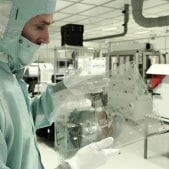Kalpana Systems, a Dutch thin film equipment manufacturer, has launched roll-to-roll spatial atomic layer deposition (sALD) tools, targeting industries such as solar PV, organic light-emitting diodes, batteries, and packaging. The technology focuses on depositing high-quality functional thin layers with atomic precision without causing sputter damage, with initial applications in barrier layer deposition. Since its founding in 2021, the company has developed its first operational machine, raising €3.5 million to transition from prototype to commercial production. The sALD technology supports high throughput industrial processes, enabling deposition of multiple layers with web speeds up to 10 m/min and is designed for integration with other deposition techniques. Two models, the K300 and K600, cater to different market needs, with specifications optimized for flexible electronics, solar cells, and high-speed applications like batteries and packaging.
The sALD equipment addresses stability and durability challenges faced by producers of perovskite and organic solar cells, offering cost-effective encapsulation methods. Both K300 and K600 models can process flexible substrates and are programmable for various operational parameters, making them versatile across roll-to-roll production processes. With lead times of 9–12 months, Kalpana Systems offers customizable customer onboarding support. Backed by investors such as Fairtree Elevant Ventures and SIG InnoVentures, the company emphasizes the uniqueness of its roll-to-roll technology in delivering high volume, rapid production, and wide market adoption. These innovations position Kalpana Systems as a competitive player in thin film deposition, advancing the development of efficient and scalable manufacturing solutions.
Kalpana Systems, founded in 2021 and headquartered in Delft, Netherlands, specializes in high-throughput spatial Atomic Layer Deposition (sALD) technology for thin film coatings on flexible substrates.Their innovative Superspatial ALD technology enables cost-effective production of thin films, facilitating the transition from technological promise to commercial application. The company's solutions are designed to advance sectors such as solid-state batteries, environmentally friendly packaging, and perovskite solar cells.
In July 2024, Kalpana Systems secured €3.5 million in a Series A funding round led by Fairtree Elevant Ventures, SIG InnoVentures, and the Energy Transition Fund Rotterdam.This investment aims to accelerate the development and commercialization of their sALD technology, positioning the company to meet the growing demand for advanced thin film deposition solutions across various industries.



%20(1).png)




















